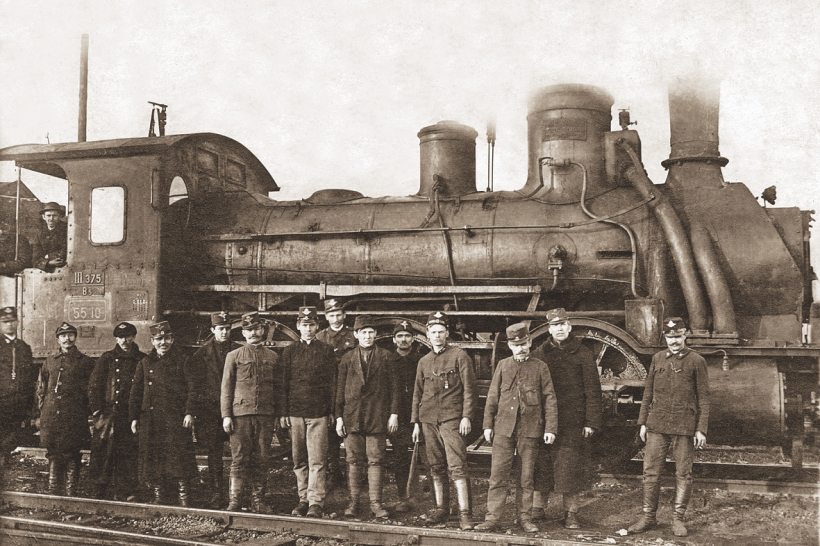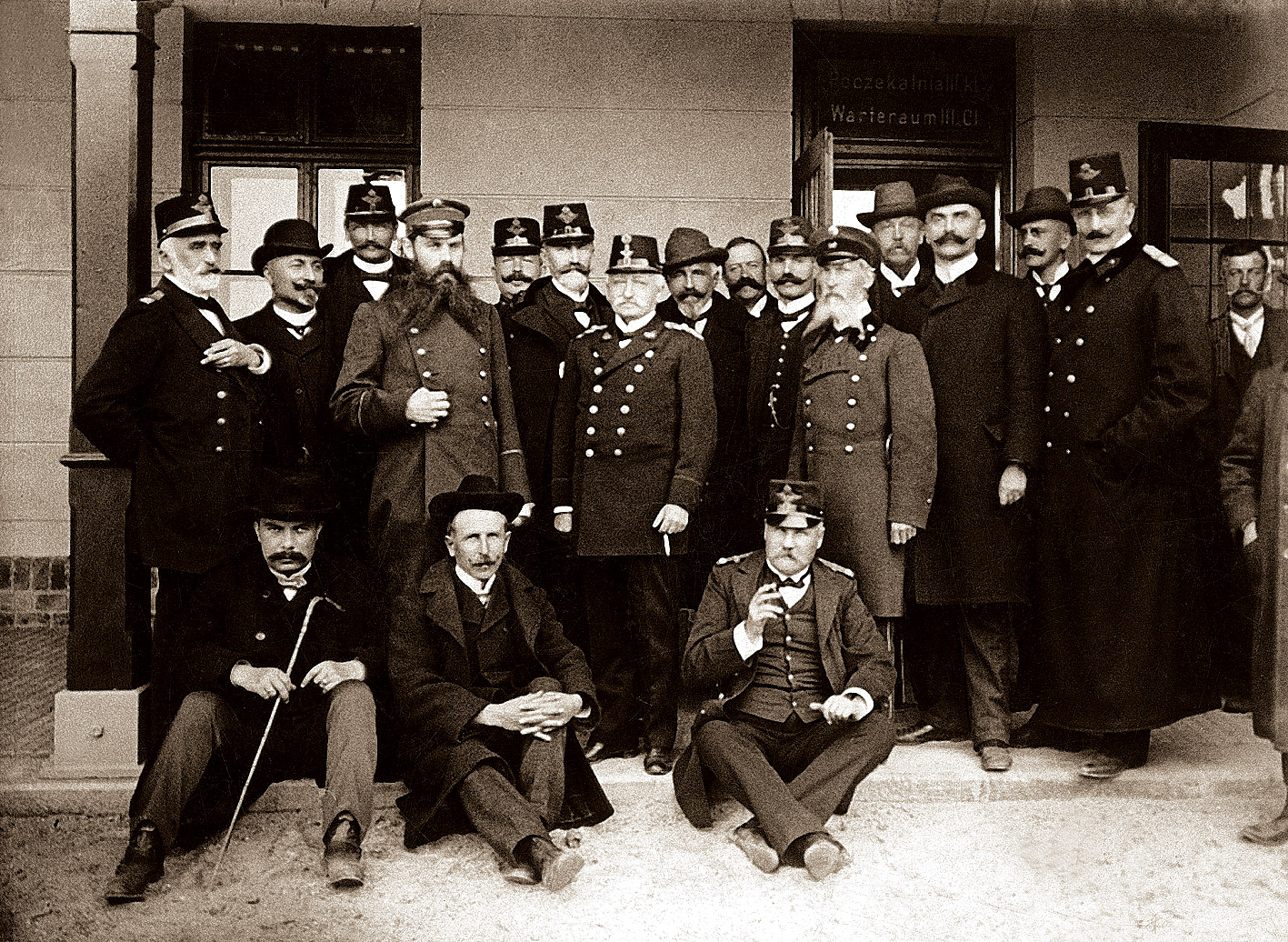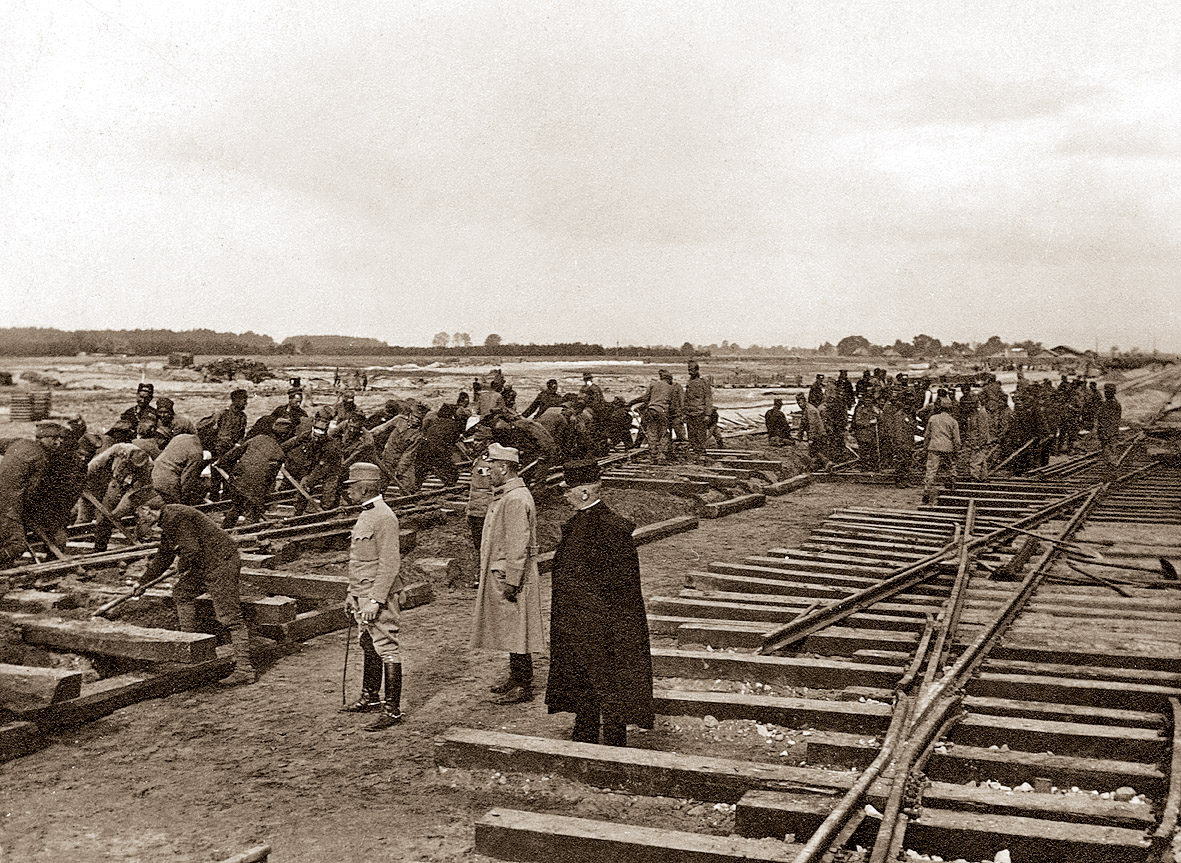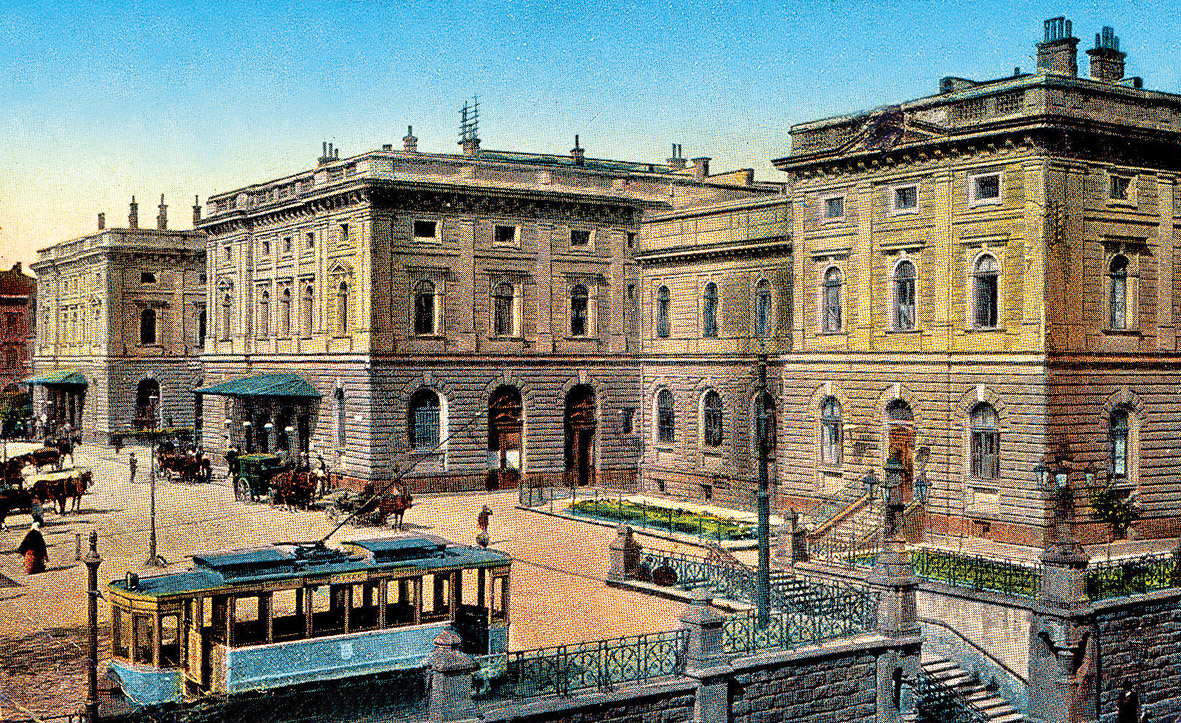
Pracownicy wydziału mechanicznego kolei we Lwowie - 1918 r.
Historia kolei
10 listopada 2020

Pracownicy wydziału mechanicznego kolei we Lwowie - 1918 r.
Krakowskie zmagania o kolej
Później spółka ta uzyskała koncesję na budowę linii z Wiednia do Bochni, gdzie znajdowały się kopalnie soli, z odgałęzieniami do Brna, Ołomuńca, Opawy, Dworów i Wieliczki. Kiedy Kolej Górnośląska przymierzała się do połączenia z Koleją Północną Cesarza Ferdynanda z pominięciem Krakowa, by temu zapobiec, z inicjatywy senatu Wolnego Miasta Krakowa powołano Towarzystwo Kolei Krakowsko-Górnośląskiej. W 1844 roku rozpoczęło ono budowę linii kolejowej ze Śląska do Krakowa przez Szczakową. Teren był trudny (ze wzniesieniami o dużym nachyleniu) i zmuszał do stawiania licznych mostów. 13 października 1847 roku z krakowskiego dworca, uznanego przez współczesnych „za jeden z dwunastu najprzedniejszych obiektów Krakowa, godnych obejrzenia” i „jeden z najpiękniejszych dworców w Europie, pierwszy parowiec krakowski ze znacznym ciągiem wagonów pojazdowych i transportowych, z uderzeniem godziny wpół do dziesiątej wyruszył szczęśliwie do Prus” (J. Demel, „Początki kolei...”). Tym samym zainaugurowano działalność pierwszej linii kolejowej na ziemiach polskich pod zaborem austriackim. Skład jechał do Mysłowic, prowadzony przez parowóz „Kraków” (Borsig nr 76/1847). Dla mieszkańców Krakowa urządzono cztery dni później przejazd „spacerowy” do Krzeszowic. Takie pociągi były uruchamiane letnią porą w niedziele i zabierały każdorazowo kilkuset pasażerów.
Początki europejskiej sieci kolejowej
Skomunikowanie z Koleją Warszawsko-Wiedeńską w Maczkach nastąpiło wiosną 1848 roku. Po spięciu Kolei Górnośląskiej Koleją Wilhelma (Koźle-Racibórz-Chałupki), odcinkiem Chałupki-Bohumin, od jesieni 1848 roku można było już dojechać z Krakowa do Wiednia w 13 godzin. Podróż do Warszawy, z przerwą na nocleg na stacji Granica, trwała 23 godziny. Połączenie się kolei trzech państw – Prus, Rosji i Austrii – zapoczątkowało powstanie europejskiej sieci kolejowej. Wiosną 1850 roku państwo austriackie przymusowo wykupiło linie od krakowskich i śląskich udziałowców, tworząc Cesarsko-Królewską Wschodnią Kolej Państwową. Pociągi pospieszne relacji Wiedeń-Kraków już w 1868 roku osiągały maksymalną prędkość 80 km/h. Po 1893 roku prędkość wzrosła do 100 km/h, wagony posiadały już oświetlenie elektryczne, pociąg prowadził wagon restauracyjny, a podróż trwała około 8 godzin.

Otwarcie linii Kraków - Kocmyrzów - 1899 r.
Uruchomienie kolejowego tranzytu
Z końcem 1852 roku Towarzystwo Akcyjne Cesarsko-Królewskiej Wyłącznie Uprzywilejowanej Kolei Północnej Cesarza Ferdynanda rozpoczęło budowę linii z Bohumina przez Dziedzice do Oświęcimia, a następnie z Oświęcimia do Trzebini i z Krakowa do Dębicy, z odnogami do Wieliczki i Niepołomic. Oddano je do użytku w 1856 roku, a dwa lata później KFNB wykupiło od państwa linie z Mysłowic do Krakowa i ze Szczakowej do Maczek. Powstałe w tym samym 1858 roku Cesarsko-Królewskie Uprzywilejowane Towarzystwo Akcyjne Galicyjskiej Kolei Karola Ludwika odkupiło połączenie z Krakowa do Dębicy (z odnogami do Wieliczki i Niepołomic) i dokończyło budowę trasy z Dębicy przez Rzeszów (1858), Przeworsk (1859), Przemyśl (1860) do Lwowa (1861) i granicznej stacji w Brodach (1869). Tory poszły również na południowy wschód przez Złoczów (1869), Tarnopol (1871) do położonych na granicy Podwołoczysk (1871). Uzyskane w ten sposób połączenie z kolejami rosyjskimi umożliwiło uruchomienie tranzytu towarowego, zwłaszcza rosyjskiego zboża do Prus. Rozpoczęcie eksploatacji złóż naftowych w rejonie Borysławia i Drohobycza, jak też eksport bydła i mięsa do Wiednia, wpłynęły na znaczną rentowność tej kolei.
Pierwsza linia państwowa
Konsorcjum z kapitałem angielskim pn. Towarzystwo Kolei Żelaznej Lwowsko-Czerniowieckiej wybudowało w latach 1864-1866 linię kolejową Lwów-Czerniowce-Jassy do granicy z Rumunią w Suczawie, otwierając w ten sposób eksport rumuńskiego zboża do Prus. Tym samym zakończył się pierwszy etap budowy połączeń w Galicji.
Doświadczenia wojen toczonych przez monarchię austro-węgierską spowodowały mocniejsze zainteresowanie się kręgów militarnych kolejami, dlatego o budowie nowych połączeń decydowały również względy strategiczne. W Galicji taką linię stanowiła kolej żelazna z twierdzy I klasy w Przemyślu do granicy węgierskiej w Łupkowie. Dokument koncesyjny dla Towarzystwa Akcyjnego Pierwszej Węgiersko-Galicyjskiej Kolei Żelaznej został wystawiony w 1869 roku z terminem ważności do 1959 roku. Trasa przebita tunelem pod Przełęczą Łupkowską, prowadząca na Nizinę Węgierską, została oddana do użytku w 1872 roku. W tym czasie prywatne konsorcjum zbudowało Kolej Dniestrzańską z Chyrowa do Stryja, z odgałęzieniem z Drohobycza do Borysławia (1872), lecz wkrótce, z powodu strat finansowych, odstąpiło ją państwu. Była to zatem pierwsza linia państwowa na terytorium zaboru austriackiego.
Plan upaństwowienia kolei
Rząd Austro-Węgier realizował plan upaństwowienia kolei, w ramach którego linie z Przemyśla do Łupkowa należące do Pierwszej Węgiersko-Galicyjskiej Kolei Żelaznej i Kolej Lwowsko-Czerniowiecka przeszły w 1889 roku pod zarząd państwowy. Podlegały one utworzonym już w 1884 roku okręgom dyrekcyjnym w Krakowie i we Lwowie (oraz nadrzędnej Dyrekcji Kolei Państwowych w Wiedniu). Kolej Północną Cesarza Ferdynanda wykupiono z rąk prywatnych w 1906 roku i podporządkowano ją bezpośrednio dyrekcji w Wiedniu.

Kontrola postępu prac podczas budowy Galicyjskiej Kolei Żelaznej - koniec XIX w.
Trasa Lwów-Kraków była położona blisko granicy z Rosją. Przebiegała w trudnym terenie przy niekorzystnym profilu linii (duże wzniesienia i spadki, ostre łuki). Aby uchronić kraj przed przerwaniem ruchu kolejowego w razie konfliktu zbrojnego, rząd postanowił wybudować równoległą do niej trasę z zachodu na wschód, od Zwardonia do Husiatyna, z włączeniem do jej ciągu istniejących odcinków Bielsko-Żywiec, Nowy Sącz-Stróże, Zagórz-Chyrów, Stryj-Stanisławów. Nowe połączenie o całkowitej długości 552 kilometry, nazwane Galicyjską Koleją Transwersalną, zostało zrealizowane bardzo szybko, bo w ciągu dwóch lat (1883-1885). Następnie połączono je z Podgórzem i Krakowem przez Skawinę.
Polacy inwestorami i akcjonariuszami
Kolejne lata przyniosły powstanie nowych linii kolejowych, zarówno tych prywatnych, jak i budowanych przez państwo. Aby zwiększyć przepustowość, w latach 80. XIX wieku zbudowano na niektórych odcinkach drugie tory. Wśród inwestorów i akcjonariuszy towarzystw kolejowych dominowali Polacy, których zaliczano także do grona najlepszych dyrektorów kolei państwowych. Byli to m.in.: inżynier Wiktor Kolosvary – dyrektor Okręgu Kolei w Krakowie, oraz inżynier Ludwik Wierzbicki – dyrektor Okręgu Kolei we Lwowie. Projektowaniem linii zajmowało się najczęściej Krajowe Biuro Kolejowe, zorganizowane przez inżyniera Kazimierza Zaleskiego we Lwowie, a prace wykonywali wybitni inżynierowie, tacy jak: Stanisław Rawicz-Kosiński (pod jego kierownictwem w Jaremczu, na linii Stanisławów-Woronienka, wybudowano most sklepiony o rozpiętości 65 i 28 metrów wysokości), Ferdynand Gisman i inni. W 1891 roku na czele Generalnej Dyrekcji Kolei w Wiedniu stanął doktor Leon Biliński, wybitny ekonomista i organizator, a także działacz społeczny i gospodarczy.

Na pocztówce z XIX w. neogotycki dworzec kolejowy w Krakowie
Koleje wspierają lokalną gospodarkę
Do budowy poszczególnych odcinków zatrudniano miejscowych robotników i wykorzystywano lokalne surowce. Kamień pochodził z okolicznych kamieniołomów, żwir z pobliskich rzek, drewno na konstrukcje zaś – z tamtejszych lasów. Budujące się koleje dawały pracę mieszkańcom, zarabiano także na sprzedaży gruntów, nastąpiło ożywienie gospodarki.
Rozwój turystyki kolejowej
Dogodne połączenia kolejowe pod koniec XIX wieku i na początku XX wieku przyczyniały się do rozwoju turystyki. Austriackie koleje państwowe wydały serię przewodników po liniach kolejowych cesarstwa. Do ośrodków wypoczynkowych kursowały pociągi wycieczkowe. Połączenie koleją lokalną Muszyny z Krynicą (1911) przyczyniło się do znacznego wzrostu liczby wczasowiczów w tym kurorcie, popularne uzdrowisko w Truskawcu uzyskało natomiast kolejowe połączenie z Drohobyczem (1912). Całkowita długość linii w Galicji przed wybuchem I wojny światowej wynosiła prawie 4300 kilometrów.